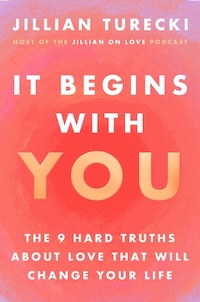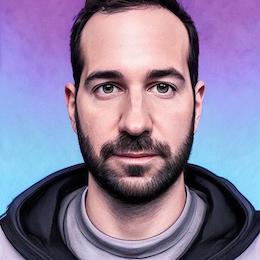
“It Begins With You” is a relationship book by Jillian Turecki. It has nine sections, each exploring a key truth about love and relationships.
Truth 1: It begins with you.
- We cannot heal our love lives without healing the relationship we have with ourselves. Every relationship we have ever had has had one thing in common: us
- Play is what makes us feel most alive. Much of our inner work is actually learning how to return to the more playful, creative parts of ourselves. Do more what is fun to you.
Truth 2: The mind is a battlefield.
- Inside our minds lives an untamed, restless monkey that swings from one fearful, critical thought to the next. Monkey mind is a Buddhist concept that describes a mental state of lack of control of one’s thoughts.
- Ask yourself: How do I feel when I’m with this person? Do I actually really like this person, or am I consumed with getting them to like me?
Truth 3: Lust is not the same thing as love.
- “Imagine you’re dating someone new, and you feel clear about how this man feels about you. You don’t have to wonder when he’ll call you next, because you know he will. You don’t hesitate to call him, because you know he’ll answer or call you back as soon as he can because he’s excited to connect with you. There’s no confusion, no mixed messages, and the relationship has a nice, steady momentum. How does that feel?”
- Some people are ready for a connection, not a relationship.
- Feeling wanted feels really good, but being desired is not the same thing as being valued.
- Chemistry is what makes us feel alive. When we can’t stop anxiously obsession about when they’re going to call or text, what we’re aching for is not actually them. Instead what we’re yearning for is a feeling. It’s the feeling of being totally alive, unburdened by the boring monotony of our lives.
- According to psychological theory, we will be physically attracted to people who register as familiar to our subconscious. This theory further suggests that our subconscious mind will choose the person who reminds it of the parent we struggle with, in an attempt to reenact painful dynamics from childhood so that we can ideally heal from our trauma.
- The truth is, “The One” is not a person. It is a metaphot for hope, change and novelty. It’s a craving, not necessarily for the other person, but for magnified, positive emotions - such as bliss, joy and happiness.
- No one exists to complete us. There was “The One” who was perfect for you when you were seventeen, and there was “The One” who came into your life when when you were twenty-five and ended up teaching you a huge lesson. There was “The One” you ended up marrying and then divorcing.
- To love someone is to love them in the ways that they need us to, not just in the ways that are comfortable for us. To love someone is to accept them for who they are. Loving someone for who they are means that we don’t try to change them into being someone who they are not. To accept someone for who they are is to accept their flaws. And what do we want more than anything else? We want to be accepted for who we are.
- How to communicate your need for a slower pace: “As much as part of me would love to see you multiple times a week, I would prefer to take a slower pace. What do you think?”
Truth 4: You have to love yourself.
- Whenever our need for someone’s love is stronger than our self-love, we will abandon ourselves in the pursuit of their attention and validation.
- My definition of self-love is self-acceptance.
- “How do I stop attracting unavailable partners?” I always respond, “When you stop choosing them.”
- Feeling stuck is probably the most common complaint I hear from people who are unhappy, and the only solution is to break up with the familiar and embrace the unfamiliar.
- Most people have a habit of speaking to themselves harshly. We have to practice speaking to ourselves with more compassion and encouragement in order to love ourselves more.
- Meet your core needs:
- the need for safety (this includes the need to feel in control)
- the need for adventure (need for change)
- the need for validation (this includes the need to feel important)
- the need for love (this includes the need for connection)
- the need to grow (this includes the need to be challenged)
- the need to give back (this includes the need for purpose)
- When we don’t see our value, we will scream Love me! Love me! to the people who never loved us, and as soon as someone does want to love us, we become the emotionally unavailable ones.
Truth 5: You must speak up and tell the truth.
- It takes immense self awareness and courage to risk rejection and the loss of connection in the name of staying true to who we value. But the truth is, losing our connection to ourselves has far greater consequences than losing our connection to another.
- Examples of self-assertion:
- “I’ve enjoyed getting to know you, but I don’t feel a romantic connection. I wish you the best of luck.”
- “I prefer not to text when getting to know someone and instead have an actual phone call.”
- “I really like you and would like to see more of you. What do you think?”
- “I know you want to talk, and I promise I am not going anywhere. I just need a few minutes to gather my thoughts, because I feel overwhelmed. Okay?”
Truth 6: You need to be your best self (even after the honeymoon).
- We must always strive to become the person we’d want to be in a relationship with.
- Romantic relationships are a mirror: they show us where our work lies.
- They believed that the other person was the problem and didn’t want to take responsibility for their role in the dynamic that wasn’t working between them.
- People are not motivated to change their behavior when they feel punished; they’re motivated by positive reinforcement.
- To love a selfish person is to suffer.
- Identify your inner saboteur: What do you do, as a form of self-protection? Do you withold? Do you pull away?
Truth 7: You cannot convince someone to love you.
- When someone you love can’t love you back, you have to let them go.
- To walk away from the person you care about who cannot meet your needs is one of the bravest acts you can do.
- One of the hardest lessons we will face in life is learning to accept when someone’s part in our story is over.
- “My feelings are growing for you and I want a real relationship. I know you are not ready, and that is okay, but I must move on.”
Truth 8: No one is coming to save you.
- Everyone thinks that the right partner will make them happy. We can’t depend on someone else to make us happy all the time.
- As we exit the falling-in-love stage and enter the committed stage of a relationship, however, we often face a rude awakening: our problems are still there and we have to deal with them. The emptiness we felt before the relationship is still there. The job we don’t like is still our job. The anxiety we struggle with returns after a brief hiatus. And we discover that the person we thought was perfect is actually just as flawed as we are.
- A relationship is meant to make us happier, not happy. Our lover can’t be the only source of security. Our relationship cannot be the only source of connection and love we feel.
- Never date someone you need to heal or reform.
- If we don’t look inside ourselves and take measures to fill our emotional voids, we will put too much pressure on a relationship to fill them for us.
- Become your own hero. Find joy in little things. Move you body often. Cultivate multiple sources of connection. Give back in some way. Let go and have fun.
Truth 9: You must make peace with your parents.
Overall, I enjoy Jillian Turecki’s content on social media, but the book didn’t resonate with me. It didn’t offer many new insights or clear takeaways—most of it felt like familiar advice. The sections didn’t flow in a logical order, and the examples often wandered off topic. As a result, the book felt more like nine separate essays than a cohesive narrative.
I’m glad I read it though, it made me attend a book club by Lisbon Therapists & Coaches Connect group where I had a chance to discuss relationships with people from all walks of life.
